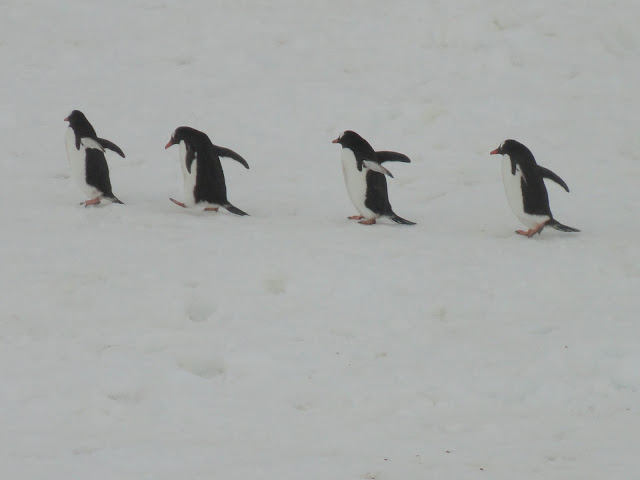The one thing I wanted to see in Antarctica was penguins in
their natural habitat, and I was not disappointed! On our very first excursion,
a zodiac cruise in Wilhelmina Bay, we saw dozens of penguins – on land, in
their rookeries, swimming in the water, and hopping out of the water. We
learned that at this time of the year they are returning to Antarctica to make
a nest, choose a mate, and breed. The chicks then have three to four months of
summer to mature and swim away before the deadly cold of an Antarctic winter
sets in. The male builds a nest out of rocks and pebbles and the female chooses
the male, based on his mating call, which sounds like a loud Spanish-r trill.
She wants the fattest male, so she chooses the one with the lowest frequency.
The low frequency indicates that the male has more fat on his throat. Again
Darwin’s “survival of the fittest” rule is working here. The penguin with more
fat can withstand the cold better and go for a longer time without eating.
One of the pair stays with the nest while the other goes out
to eat. They eat krill, tiny pink shrimp and so their poop is pink. Doesn’t
that sound dainty? Pink penguin poop! Say that fast five times! The snow of the
rookery (penguin colony) develops a pink tint, and rocks become discolored
permanently. The penguins walk the same path to and from the water. You can see
the trails in the snow. The trails are only wide enough for one lane of penguin
traffic in each direction. Therefore, the penguins walk in a line, just like
you see in the cartoons and movies. The guides called these “penguin highways.”
The penguins often deviate from their highways, though. We had to be careful to
stay fifteen feet away from the wildlife, including their highways, but they
could come closer to us. On our excursion to Paradise Bay we landed near two
rookeries and stayed there for one and a half hours. I spent the whole time
sitting in the snow, watching the penguins, and taking pictures and videos. The
penguins got used to our camp and started walking closer to us. One penguin
even stopped to check us out!
Pictures show a rookery, a close-up of the rookery, four
penguins walking in a row, penguins near people, and one penguin hopping out of
the water. In the picture that shows
penguins walking up the hill you can see two distinct trails, or penguin
highways.






No comments:
Post a Comment